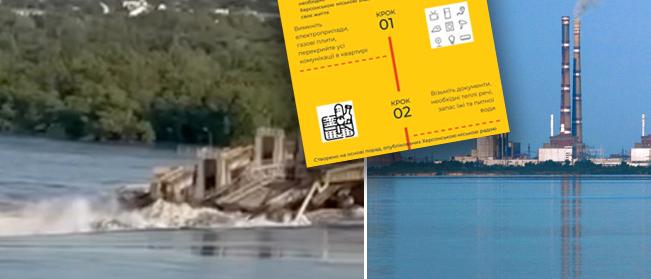Published: Less than 10 min ago
Up to 80 communities may be drowned after the Kakhovka dam bursts.
Ukrainian authorities report that 16,000 people are in “critical areas”.
– The situation is made worse by washed away roads. Evacuation personnel are looking for other ways to get there, says Ukrainian Interior Minister Ihor Klymenko.
The water in the Kakhovka reservoir is dropping drastically, according to the state-owned Ukrainian nuclear power company, Energoatom.
Several areas below the now destroyed power plant are now affected by high water levels and the situation is described as critical in several places.
Floods and problems with water supply
By Tuesday morning, several villages had been flooded or partially flooded, Kherson region’s military chief and governor, Oleksandr Prokudin, announced on Telegram.
Around 16,000 people were then in a “critical zone” on the northern bank of the river Dnieper.
Evacuations have begun, initially by bus to the city of Kherson and then by train to other Ukrainian cities.
On social media, among others, the Ukrainian Southern Military Command distributed information leaflets to the population in the area. They were told to gather their “necessary documents”, turn off all electrical appliances and pack food and drink.
From both the Ukrainian and Russian sides there are now warnings that the water supply may be affected.
President Zelenskyi has previously told the BBC that a possible explosion would affect large parts of southern Ukraine’s water supply.
The Russian state news agency Tass now believes that Crimea’s water supply may also be affected by the destroyed dam.
Risks for the nuclear power plant in Zaporizhzhya
The rising water levels are described as a threat to the nuclear power plant in Zaporizhzhya.
– A more global threat is the situation at the enemy-occupied Zaporizhzhya nuclear power plant, says Ukrainian Interior Minister Ihor Klymenko.
The power plant, which is Europe’s largest, needs the water from the Kakhovka reservoir for its cooling.
The state-owned Ukrainian nuclear power company, Energoatom, writes that the water from the reservoir is used to power turbines and safety systems. At the moment, the situation is described as “under control”.
The UN’s International Atomic Energy Agency (IAEA) is on site at the nuclear power plant. They say they are aware of the damage, but also do not see any immediate risk to the nuclear power plant.
Ukraine has previously warned that Russia planned a staged accident to slow Ukraine’s offensive. A possible “accident” could force an inspection of the nuclear power plant in Zaporizhzhya.
The Ukrainian Ministry of Defense believed that Russia intended to shell the power plant and then raise the alarm about a leak. Should that happen, an international investigation must be carried out. In such a case, all fighting must cease and a possible Ukrainian offensive can be delayed.
More difficult to pass the Dnieper
In a press release on Tuesday morning, the Ukrainian military intelligence service wrote that the destruction of the dam was an “attempt to complicate the actions of the Ukrainian security and defense forces”.
The Kakhovka Dam was one of the few passages across the Dnieper River into areas occupied by Russia.
In the past, other important bridges to the Kherson region have struck out to prevent Russian transports. Last year the Antonivskiy bridge was fired upon by Himars rockets by Ukraine.
FACTS
This has happened
arrow During the night of Tuesday, the Kakhovka dam in southern Ukraine, which controls the flow of the Dnieper river, burst.
arrow Kherson region military chief and governor Oleksandr Prokudin says evacuations have begun.
arrow Russia believes that the dam burst as a result of “terror”.
arrow Ukraine says that the dam was blown up by Russia and believes that the water levels will become “critical” during Tuesday morning.
arrow Volodymyr Zelenskyy has called a crisis meeting connected to the incident.
Read more
